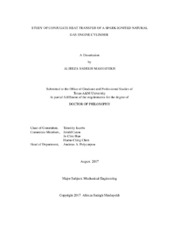| dc.description.abstract | Large bore two-stroke natural gas engines are facing more stringent emission regulations in the near future. In order to comply with these new regulations, engine manufacturers have to modify their engines. Redesigning some relevant parts and/or modifications to the combustion setup of these engines are in order. A deeper understanding and analysis of all the details of the combustion process could help researchers/engineers in these modifications. While the experimental methods are still the primary way of analyzing internal combustion engines, recent advances in numerical methods, and the computing power of clusters (supercomputers) have opened a new path ahead of engine designers. Using numerical tools could significantly reduce the costs associated with engine modifications.
Three-dimensional CFD tools are the most accurate and detailed numerical tools available for engine research. CFD simulations of engines could reveal all the details of all the processes that happen in an engine: the air and fuel intake, mixing of the two, scavenging process, and the power cycle are some of the processes that could be looked into, using CFD tools.
The current study represents the numerical simulation of a large bore natural gas engine, using a commercial CFD software package, along with the required experimental study to validate the results of the simulation work. This document includes the case setup process for the numerical simulation, which includes the simulation of the reed valve (the air/fuel ratio control system of the engine), the simulation of the scavenging process, the simulation of the combustion process, and the conjugate heat transfer simulation between the solid parts of the engine and the cooling system. The study of conjugate heat transfer -which is the main objective of this research- provides researchers with the spatial temperature distribution on all the parts surrounding the combustion chamber. The results show relatively higher temperatures near and around the spark plug and the air-start cavity. These results could be used for an improved mechanical design of relevant parts, and redesign of parts and/or combustion/cooling setup to reduce the emission production.
The simulation results were all validated by experimental data. Stuffing box pressure, in-cylinder pressure, and equivalence ratio of the stuffing box mixture were the validation criteria for the numerical results. In addition, a single temperature measurement in the solid parts was used for partial validation of the CHT simulations. This dissertation discusses the test apparatus, and the process of acquiring the required experimental data for validation purposes as well. | en |


